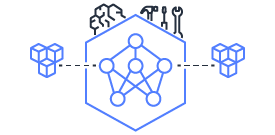Performance Tuning#
Important
NeuronCore Groups (NCG) have been deprecated. See 10/27/2021 - End of support for NeuronCore Groups (NCG) and Migrate your application to Neuron Runtime 2.x (libnrt.so) for more details.
This guide is intended to provide the reader with an in-depth understanding of how to optimize neural network performance on Inferentia for both throughput and latency. For simplicity, the guide uses the TensorFlow and ResNet-50 models as teaching examples to show how to choose between different compile-time optimizations (e.g., Batching and NeuronCore Pipeline), as well as model-serving optimizations (e.g., multi-threading and dynamic-batching) to improve inference performance.
The following guides are considered to be prerequisites for this tutorial:
tensorflow-serving-neurocore-group
Batching and pipelining (technical background)#
Neuron provides developers with various performance optimization features.
Two of the most widely used features are batching and pipelining. Both techniques aim to keep the data close to the compute engines, but they achieve this data locality in different ways. In batching it is achieved by loading the data into an on-chip cache and reusing it multiple times for multiple different model-inputs, while in pipelining it is achieved by caching all model parameters into the on-chip cache across multiple NeuronCores and streaming the calculation across them.
As a general rule of thumb, batching is preferred for applications that aim to optimize throughput and cost at the expense of latency, while pipelining is preferred for applications with a high-throughput requirement under a strict latency budget.
Compiling for batching optimization#
To enable batching optimization, the model must first be compiled for a target batch-size. This is done by specifying the batch size in the input tensor’s batch dimension during compilation. Users are encouraged to evaluate multiple batch size, in order to determine the optimal latency/throughput deployment-point, which is application-dependent.
For example, the code snippet below enables batching on a ResNet50 model, with a batch-size of 5:
import numpy as np
import tensorflow.neuron as tfn
# To change the batch size, change the first dimension in example_input
batch_size = 5
example_input = np.zeros([batch_size,224,224,3], dtype='float16')
tfn.saved_model.compile("rn50_fp16",
"rn50_fp16_compiled/1",
model_feed_dict={'input_1:0': example_input },
dynamic_batch_size=True)
Note
Depending on the size of the neural network, Neuron has a maximum batch size that works optimally on Inferentia. If an unsupported batch size is used, an internal compiler error message will be displayed. A simple way to explore optimal batch size for your specific model is to increment the batch size from 1 upward, one at a time, and test application performance.
Compiling for pipeline optimization#
In NeuronCore Pipeline mode, Neuron stores the model parameters in
Inferentias’ local cache and streams inference requests across
the available NeuronCores, as specified by the
--neuroncore-pipeline-cores compiler argument. For example, to
compile the model to fit a pipeline size of four Inferentia devices (16
NeuronCores) avaliable in the inf1.6xlarge instance size:
import numpy as np
import tensorflow.neuron as tfn
compiler_args = ['--neuroncore-pipeline-cores', '16']
example_input = np.zeros([1,224,224,3], dtype='float16')
tfn.saved_model.compile("rn50_fp16",
"rn50_fp16_compiled/1",
model_feed_dict={'input_1:0': example_input },
compiler_args=compiler_args)
The minimum number of NeuronCores needed to run a compiled model can be found using the Neuron Check Model tool. See Neuron Check Model.
Model-serving inference optimizations#
To fully realize the maximum throughput of the compiled model (for either batching and pipelining), users need to launch multiple host CPU threads to feed inputs into the Neuron pipeline. The number of threads needs to be larger than the specified maximum number of NeuronCores.
Additionally, dynamic batching can be used to process a larger
client-side inference batch-size and the framework automatically breaks
up the user-batch into smaller batch sizes, to match the compiled
batch-size. This technique increases the achievable throughput by hiding
the framework-to-neuron overhead, and amortizing it over a larger batch
size. To use dynamic batching, set the argument
--dynamic_batch_size=True during compilation and send a larger
inference batch size (user inference batch size) that is equal to a
multiple of the compiled batch size.
Both methods can be applied together if this improves performance. However, multi-threading is always needed as a first step to achieve high throughput. You need to experiment to find optimal settings for your application.
By default the framework sets the number of outstanding inference requests to the total number of NeuronCores plus three. This can be changed by setting the NEURON_MAX_NUM_INFERS environment variable. For example, if the compiled model includes CPU partitions (e.g., if the Neuron compiler decides that some operations are more efficient to execute on CPU), the number of threads needs to be increased to account for the additional compute performed on the CPU. Note that the available instance host memory size needs to be taken into consideration to prevent out-of-memory errors. As above, you need to experiment in order to find the optimal settings for your application.
Note
By default the framework allocates a NeuronCore Group size to
match the size of the compiled model. The size of the model is the
number of NeuronCores limit passed to compiler during compilation
(--neuroncore-pipeline-cores option). For more information see the
tensorflow-serving-neurocore-group.
Other considerations#
Mixed Precision#
You can find more information about performance and accuracy trade offs in Mixed precision and performance-accuracy tuning (neuron-cc).
Operator support#
The Neuron Compiler maintains an evolving list of supported operators for each framework: Neuron Supported operators
AWS Neuron handles unsupported operators by partitioning the graph into subgraphs and executing them on different targets (e.g., NeuronCore partition, CPU partition). If the entire model can run on Inferentia (i.e., all operators are supported), then it will be compiled into a single subgraph, which will be executed by a NeuronCore Group.
Debug#
You can examine the post-compiled model to view the compilation results using the Neuron plugin for TensorBoard. See Visualize graphs executed on Neuron.
ResNet-50 optimization example#
For an example demonstrating the concepts described here, see Tensorflow ResNet 50 Optimization Tutorial
